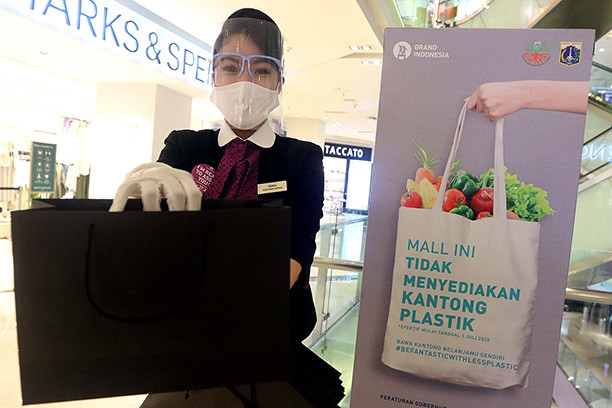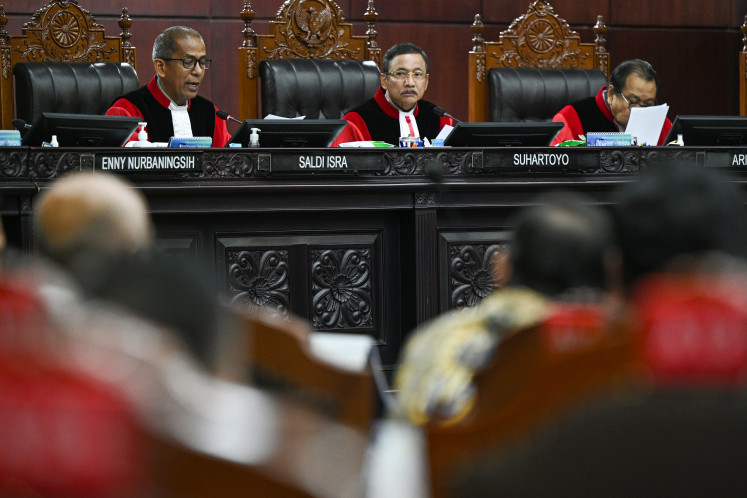Popular Reads
Top Results
Can't find what you're looking for?
View all search resultsPopular Reads
Top Results
Can't find what you're looking for?
View all search resultsThree reasons why banning plastic bags is problematic
Latest research shows plastic bags make up only a fraction of marine debris in the waters of Greater Jakarta.
Change text size
Gift Premium Articles
to Anyone
 No plastic bags: A front desk worker distributes reusable bags
to visitors at Grand Indonesia on July 1, as the shopping
center in Central Jakarta no longer provides single-use plastic bags. A gubernatorial regulation on mandatory use of environmentally friendly shopping bags in shopping centers, convenience stores and traditional markets came into force on July 1. (JP/Dhoni Setiawan)
No plastic bags: A front desk worker distributes reusable bags
to visitors at Grand Indonesia on July 1, as the shopping
center in Central Jakarta no longer provides single-use plastic bags. A gubernatorial regulation on mandatory use of environmentally friendly shopping bags in shopping centers, convenience stores and traditional markets came into force on July 1. (JP/Dhoni Setiawan)
T
here has been a growing trend of restrictions and bans on plastic bag use worldwide. By mid-2018, over 127 countries had enacted regulations limiting their use, a more than threefold increase over the last decade.
The latest adherents are Jakarta, the capital of Indonesia, the second-largest polluter of plastic waste into the oceans, and Japan, which ranks second for volume of single-use plastic packaging per person. On July 1, both Jakarta and Japan banned the use of free plastic bags at checkout counters.
These recent policies in Jakarta (an outright prohibition) and Japan (a surcharge) are important steps by politicians towards shifting away from a linear economy in which resources are often used once and then discarded. They should indeed decrease the number of plastic bags that end up in landfills, clog sewer systems, spoil our landscapes, degrade into secondary microplastic pollution and kill wildlife. They may also raise environmental consciousness among consumers.
Despite the good intentions of these new rules, plastic bag bans are problematic for a few reasons.
1. They are not the largest sources of plastic pollution
Plastic waste is indeed a very serious problem. Humans use as many as 1 trillion single-use “carrier bags”, about 128 per person per year. The total for all single-use plastic is much greater, at 150 million tons per year. Think of this as 19.23kg of single-use bottles, cutlery, straws, packaging and more for every single person on the planet.
However, the latest research shows plastic bags make up only a fraction of marine debris in the waters of Greater Jakarta. Thin or thick plastic wraps and sacks constitute just over 13.5 percent of all debris items found and 8.5 percent of their weight.
In Japan, plastic shopping bags account for only about 2 percent of all plastic waste produced in the country.
Moreover, while plastic bags are visible to us all, we need to remember that what is in them is often more harmful to the environment than the bags themselves. For example, products with heavy plastic packaging and containers can weigh many times more than the bag. Or consider the actual items, from toxic cleaning solvents, to high-food-mile imported strawberries, to soda in an aluminum can.
2. Consumers may shift to worse alternatives
Evidence from previous plastic bag restrictions shows this does reduce their use, but sometimes leads to more environmental harm if customers switch to other materials with larger resource footprints.
Paper bags can require 400 percent more energy to make, not to mention the harvesting of trees and use of noxious chemicals in production. Growing cotton “requires land, huge quantities of water, chemical fertilizers and pesticides”.
Plastic bags use fossil fuels, a nonrenewable resource, and are permanent, entering the waste stream forever. They may cause more pollution on land and in waterways, but have less effect on climate change and land use than other types of bags.
Biodegradable bags, perhaps surprisingly, could be “the worst option” in terms of their impact on climate, harm to soil, water pollution and toxic emissions.
In the end, a decision on the type of bag becomes about which particular environmental issue takes priority.
3. Consumers, who feel good about not using plastic bags, may do more harm in other ways
Researchers in psychology have observed people often harm the environment when they try to save the planet. For example, they might buy more of a product, like groceries, because they are labeled as eco-friendly.
This is related to the concept of compensatory behavior.
For example, people may feel that, since they recycle, they don’t need to consider the extra meat they ate that week. Or because they walked instead of driving to the store, they deserve to buy an extra piece of clothing.
Sometimes compensatory action takes the form of attempts to account for previous harms. For example, buying carbon offsets for flying might make a passenger feel good, but from an environmental perspective, it’s less desirable than not boarding in the first place.
The point here is that reducing plastic bag use might grant people mental license to take other actions that are more detrimental to the environment.
So where does this leave us, and what should we do?
What’s next?
Ultimately, the greatest gain from plastic bag bans and pricing is probably in shifting environmental outlooks.
Research connects charges for plastic bags to attitudinal changes among consumers, including support for additional environmental policies.
There can be broader shifts in norms, as “the emergence around the world of an anti-plastic bag norm has been rapid and widespread”. The hope is that increased consciousness in this part of our lives will raise awareness about environmental impacts and alter behavior in other ways.
This leads to some insights about bags.
For example, according to the UN Environment Program, a cloth bag used between 50 and 150 times will have a lower climate impact than a single-use plastic bag.
When it comes to a plastic bag, if you want to want to halve the environmental harm, use it twice. Drop it to 25 percent? Use it four times. Reduce the impact by 90 percent? Use it ten times.
And if we do get reusable bags, we really need to re-use, re-use and re-use them. As an article in Popular Science has pointed out: “Regardless of the material, the best bags are the ones you already own.”
In the end, should plastic bag bans be banned? Not exactly, but the entire story of their effects must be more closely considered.
***
David D. Sussman is Visiting Scholar, Tufts University.
This article is republished from The Conversation under a Creative Commons license. Read the original article.










